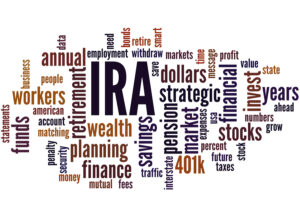How does an IRA work?
*Disclaimer: Any Information found on website is for education purposes and is not tailored to the investment needs of any specific investor. Investing involves risk, including risk of loss.

What is an IRA?
An individual retirement account (IRA) is defined as a tax-advantage investing tool that can be used to help save for retirement. Anyone who has a social or ITIN (sometimes) can open an IRA. An IRA is considered a qualified plan.
An IRA can be set up by a financial institution with your selected mutual fund, annuity or other type of investment that you select. There are a few types of IRAs such as:
- Traditional IRAs
- Roth IRAs
- SEP IRAs
- Simple IRAs
No matter what type of IRA you have or considering you can make contributions up to a certain limit that will be explained by a financial advisor or tax advisor.
The type of investments one can make consist of:
- stocks
- bonds
- mutual funds
- annuity funds and
- other types of investment company securities.
These are considered ineligible for use in an IRA:
- Collectibles (antiques, gems, rare coins, works of art, stamps)
- Life insurance
Prohibited Practices
There are a few investment practices that are inappropriate such as no short sales of stock, speculative option strategies, tax-exempt municipal securities, or margin account trading.
How does a Traditional IRA work?
A traditional Individual Retirement Account (IRA) is a qualified plan that allows the earnings in the account to grow tax deferred.
Contributions to a traditional IRA can take a tax deduction for the amount of the contribution for the year. You can’t take a tax deduction if you are actively participating in a 401k plan.
Distribution/withdrawals – may begin after age 59.5 and must begin by April 1 of the year after the individual turns 70.5. If money is taken out before age 59.5 expect a 10% penalty + regular income tax. There are a few exceptions in the event of:
- death
- disability
- first-time homebuyer for principal residence
- education expenses for taxpayer, spouse, child, or grandchild
- medical premiums for unemployed individuals
- medical expenses in excess of defined AGI limits
If distribution does not begin by April 1st of the year after you turn 70.5, a 50% insufficient distribution penalty applies. Its relevant to the amount that should have been withdrawn based on the IRS life expectancy tables. This is also known as the IRA holder’s annual required minimum distribution (RMD) and required beginning date (RBD).
*Ordinary income taxes will apply to the full amount
Rollovers and transfers – Individuals may move the funds and investments in a qualified plan and move to another qualified plan. Rollovers and transfers can only be done once every 12 months. All rollovers must be completed within 60 calendar days of withdrawal.
*rollovers must be done by a licensed securities agent to avoid taxes and fees
*If you are younger than 59.5 and you withdrawal funds on your own. You will be taxed 10% penalty plus regular income tax.
How does a Roth IRA work?
A roth individual retirement account (IRA) is defined as a qualified plan that allows after-tax contributions up to a maximum annual allowable limit per individual per year.
Contributions to a Roth IRA is not deductible on one’s tax return.
Earnings are not taxed as they accrue or when they are distributed from an account as long as the money has been in the account for 5 taxable years and the owner has reached age 59.5. There is no maximum age that the individual must take out the money. However if the owner of the account passes away, the beneficiary must begin taking distributions (rules change if spouse, check w/ your financial advisor or Tax advisor).
SIMPLE IRAs
A SIMPLE IRA is an employer-sponsored retirement plan offered by small businesses with 100 employees or less. SIMPLE stands for Savings incentive match for employees. Plan participants typically receive a list of investments to pick from.
Contributions to SIMPLE IRAs are made pretax, and earnings accumulate tax deferred. Employers are required to make minimum matching contributions.
SEP (Simplified Employee Pension) IRA
A SEP IRA is a self-employed individual retirement account that can be used by independent contractors, freelancers, and small business owners with 25 or fewer employees.
SEP IRA follows the same distribution rules as a traditional IRA.
No matter what type of IRA you have. You should try to contribute the maximum amount to your IRA each year to get the maximum of your savings for retirement. Its also important to monitor your investments and to communicate with your financial advisor especially if your investment goals have changed.
Investing involves risk, including risk of loss.
This information is intended to be educational and is not tailored to the investment needs of any specific investor.

